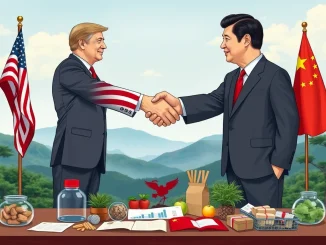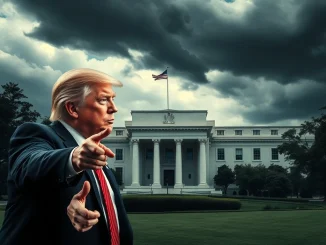
Get ready for a potential economic earthquake! Former U.S. President Donald Trump has once again ignited global trade discussions with a bold proposition: a flat 10% tariff on all US imports. This isn’t just a minor tweak; it’s a sweeping policy that could reshape international commerce and have significant repercussions across various sectors, including, potentially, the cryptocurrency market. Let’s dive into what this could mean and why it’s making headlines.
What are Trump Tariffs and Why Now?
According to reports from the Wall Street Journal, Trump’s announcement signals a move towards what he terms “reciprocal tariffs.” Essentially, this means the U.S. would impose a standard 10% tax on every single product entering the country from any nation. For countries perceived as having unfair trade practices against the U.S., Trump hinted at even steeper tariffs. This isn’t just about specific goods or nations; it’s a blanket approach.
But why is this being proposed now? Trump argues these measures are designed to:
- Boost American Manufacturing: The core idea is to make imported goods more expensive, thereby incentivizing businesses to produce goods within the U.S. This, Trump claims, will “bring jobs and factories back to the U.S.”
- Reduce Trade Deficits: By increasing the cost of imports, the aim is to reduce the amount of goods the U.S. buys from other countries, potentially narrowing the trade deficit.
- Increase Government Revenue: Tariffs are essentially taxes on imports. These taxes would generate revenue for the U.S. government.
Trump has stated he plans to sign an executive order to formalize these Trump tariffs, underscoring his commitment to this policy. He believes this will be a cornerstone in making America “wealthy again.”
[img]
President Trump’s tariff proposal could drastically alter global trade dynamics.
How Could a 10% Tariff on US Imports Impact Global Trade?
A 10% tariff on all US imports is a significant move with potentially far-reaching consequences for global trade. It’s not just a bilateral issue; it’s a global one. Here’s a breakdown of potential impacts:
- Increased Consumer Prices: Tariffs are ultimately paid by consumers. When import costs rise due to tariffs, businesses are likely to pass those costs on to consumers in the form of higher prices for goods ranging from electronics to clothing and food.
- Retaliatory Tariffs: Other countries may retaliate by imposing their own tariffs on U.S. exports. This could trigger a trade war, where multiple countries impose tariffs on each other’s goods, leading to a significant slowdown in global trade and economic activity.
- Supply Chain Disruptions: Many industries rely on global supply chains. Tariffs can disrupt these chains, making it more expensive and complex for businesses to source components and finished products. This could lead to production delays and shortages.
- Reduced Global Economic Growth: Widespread tariffs can dampen global trade, which is a major engine of economic growth. Reduced trade can lead to slower economic growth worldwide, potentially impacting employment and investment.
- Currency Fluctuations: Major shifts in trade policy can influence currency exchange rates. The U.S. dollar and currencies of countries heavily involved in trade with the U.S. could experience volatility.
What is the Potential Economic Impact of These Tariffs?
The economic impact of a 10% tariff on all US imports is a subject of intense debate among economists. Here are some key considerations:
| Potential Benefit | Potential Drawback |
|---|---|
| Boost to Domestic Industries: Some U.S. industries, particularly manufacturing, might see a boost as imported goods become more expensive, making domestically produced goods more competitive. | Higher Inflation: Increased import costs are likely to fuel inflation, eroding purchasing power for consumers and potentially leading to higher interest rates. |
| Increased Government Revenue: Tariffs would generate revenue for the U.S. government, which could be used to fund other programs or reduce the national debt. | Trade Wars and Retaliation: As mentioned earlier, retaliatory tariffs from other countries could harm U.S. export industries and lead to a broader trade war, damaging the global economy. |
| Potential for Job Creation in Specific Sectors: If domestic manufacturing increases, it could lead to job creation in those sectors. | Job Losses in Other Sectors: Sectors that rely heavily on imports or exports, such as retail, agriculture, and technology, could face job losses due to higher costs and reduced trade. |
It’s important to note that the actual economic impact would depend on various factors, including how other countries respond, the specific implementation of the tariffs, and the overall state of the global economy. Many economists believe that the negative consequences of such broad tariffs would outweigh any potential benefits.
Could Trump Tariffs Affect the Cryptocurrency Market?
While the direct link between Trump tariffs and the cryptocurrency market might not be immediately obvious, there are several potential indirect connections:
- Economic Uncertainty: Major trade policy shifts create economic uncertainty. In times of uncertainty, some investors turn to assets perceived as safe havens or alternative investments, and cryptocurrencies like Bitcoin are sometimes considered in this category. Increased volatility in traditional markets due to trade tensions could drive some capital into crypto.
- Inflationary Pressures: If tariffs lead to higher inflation, as many economists predict, this could also make cryptocurrencies more attractive as a hedge against inflation. Bitcoin, in particular, is often touted as a “digital gold” and a store of value in inflationary environments.
- Geopolitical Risk: Trade wars are often intertwined with geopolitical tensions. Increased global instability can sometimes lead to increased interest in decentralized and borderless assets like cryptocurrencies.
- Impact on Tech Sector: The technology sector, which is closely linked to the cryptocurrency industry, could be significantly affected by tariffs, especially on electronic components and goods. This could indirectly impact the crypto space.
However, it’s crucial to remember that the cryptocurrency market is influenced by a multitude of factors, and the impact of tariffs would likely be just one piece of the puzzle. Market sentiment, regulatory developments, technological advancements, and broader economic trends all play significant roles.
Actionable Insights: What Should Investors and Businesses Watch For?
For investors and businesses navigating this evolving trade landscape, here are some actionable insights:
- Monitor Trade Policy Developments Closely: Stay informed about the specific details of any tariff policies implemented, including which goods and countries are affected and the level of tariffs. Follow news from reputable sources like the Wall Street Journal, Reuters, and Bloomberg.
- Assess Supply Chain Vulnerabilities: Businesses should evaluate their supply chains to identify potential vulnerabilities to tariffs. Consider diversifying suppliers, exploring domestic sourcing options, or adjusting pricing strategies to mitigate tariff impacts.
- Consider Currency Risk Management: Businesses involved in international trade should pay close attention to currency fluctuations and consider hedging strategies to manage currency risk.
- Stay Informed about Economic Data: Keep an eye on key economic indicators like inflation, GDP growth, and trade balances to assess the broader economic impact of tariffs.
- For Crypto Investors: While tariffs could indirectly influence the crypto market, conduct thorough research and consider a diversified investment strategy. Don’t make investment decisions solely based on tariff announcements.
Conclusion: Navigating the Unpredictable Waters of Global Trade
Trump’s proposal for a 10% tariff on all US imports is a significant development with the potential to reshape global trade and have a ripple effect across the economic impact landscape. While the stated goals are to boost domestic manufacturing and reduce trade deficits, the potential downsides, including higher consumer prices, retaliatory tariffs, and economic impact uncertainty, are substantial. The cryptocurrency market, while not directly targeted, could also feel indirect effects through broader economic shifts and investor sentiment.
As this situation unfolds, staying informed, adaptable, and strategic will be crucial for businesses and investors alike. The world of international trade is complex and interconnected, and policy changes in one major economy can send waves across the globe. The coming months will be critical in observing how these proposals develop and what their ultimate consequences will be for the global economy and potentially, the digital asset space.



